@TBPInvictus
In yet another assault on economics, which is already begging for mercy in the wake of his ongoing intellectual dishonesty, Mark Perry recently tweeted the following:
Coincidence? Restaurant jobs in WA state ex-Seattle are up +5,600 since Jan. vs. down in Seattle MSA by -100? pic.twitter.com/lB8DZmHhai
— Mark J. Perry (@Mark_J_Perry) September 22, 2015
What Perry is trying to get at, of course, is that the new minimum wage in Seattle – implemented in April of this year – is failing miserably already. Except, not so much, as I’ll explain.
Although I understand the constraints of Twitter, reducing the Seattle-Tacoma-Bellevue Metropolitan Statistical Area (MSA) to the “Seattle MSA” is beyond misleading. (Beyond that, my first question was, “What does January 2015 have to do with anything? It was neither when the law was passed nor enacted. It’s an arbitrary cutoff signifying nothing.”) Wrote a regional economist – Dr. Annaliese Vance-Sherman – with whom I corresponded about Perry’s tweet (emphasis mine):
It is not possible to draw conclusions about the city based on the MSA.
I think it is important to remember that the $15 minimum wage was a city-level ordinance. The City of Seattle falls within a large urban county (King County), which consists of 39 cities including Seattle. In turn, the county is one of three large urban counties that make up the Seattle MSA.
People from the City of Seattle are not going to drive two counties north or south, or cross the mountains, for a burger. If there is a border effect, it would be well within the MSA (well within the boundaries of the county, actually), and would register as a net zero change.
Without re-creating the chart, what could be showing up in this chart is that the recovery in Seattle has been stronger (and earlier) than the remainder of the state. The increased momentum in hiring could be representative of the relatively delayed recovery outside of the Seattle MSA.
Dr. Vance-Sherman’s final comment – that perhaps there’s a bit of catch up going on – had been my immediate thought, and I’ll have more on that below, but first things first. (By the way, it should be readily apparent that Dr. Vance-Sherman is echoing everything I’ve written in just about every post I’ve published on this subject.) The Seattle-Tacoma-Bellevue MSA is, in a word, huge. It encompasses three counties – King, Pierce, and Snohomish. It looks like this, as I pointed out in this post: 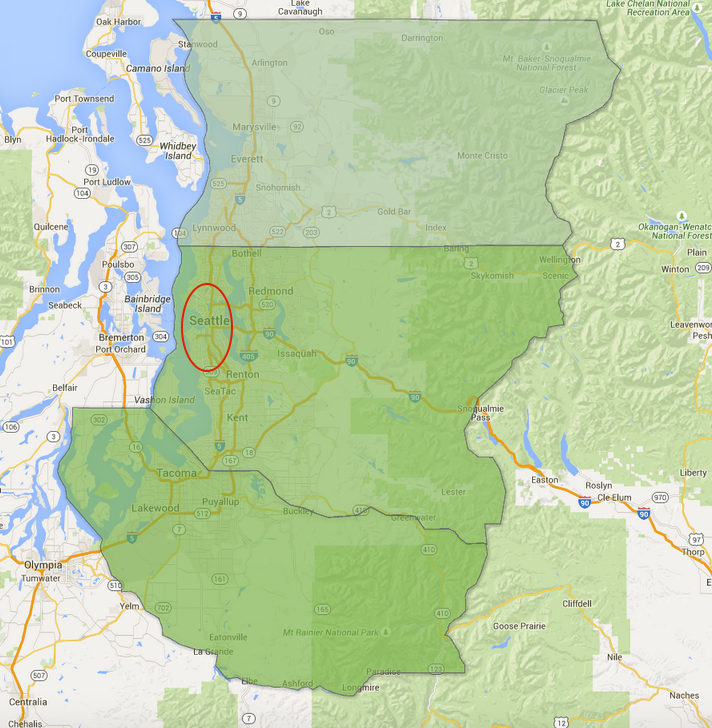
The Sea-Tac-Belle MSA has a population of about 3.6 million versus the city of Seattle’s 660,000 (more than 5x). It is the 15th largest MSA in the country and covers 5,872.35 sq mi. A business opening or closing in, say, Oso – over an hour’s drive to the north from Seattle – would be captured in the Sea-Tac-Belle MSA data. And yet the good professor insists that we can glean valuable information about the effects of the new minimum wage in the city of Seattle by looking at the Sea-Tac-Belle MSA. What he is doing, in fact, is nothing more than manufacturing lies for the right-wing echo chamber, very much including Fox News, which regurgitates his misinformation unquestioningly and unflinchingly. It is a shameful sight to behold.
To clarify exactly how useless Professor Perry’s information is, let’s try to break the numbers down as best we can. We can, in fact, get numbers for the city of Seattle proper. Unfortunately, we can only get them every five years – from the Economic Census – and last got them for 2012. In that year, the city had 38,483 employees in NAICS Code 722 – Food Services and Drinking Places – versus the 135,000 currently in the Sea-Tac-Belle MSA. So, the MSA (now) has roughly 100,000 more food services employees than the city itself (in 2012). In other words, inferring anything about the city from the MSA is an exercise in futility, and Perry knows it. 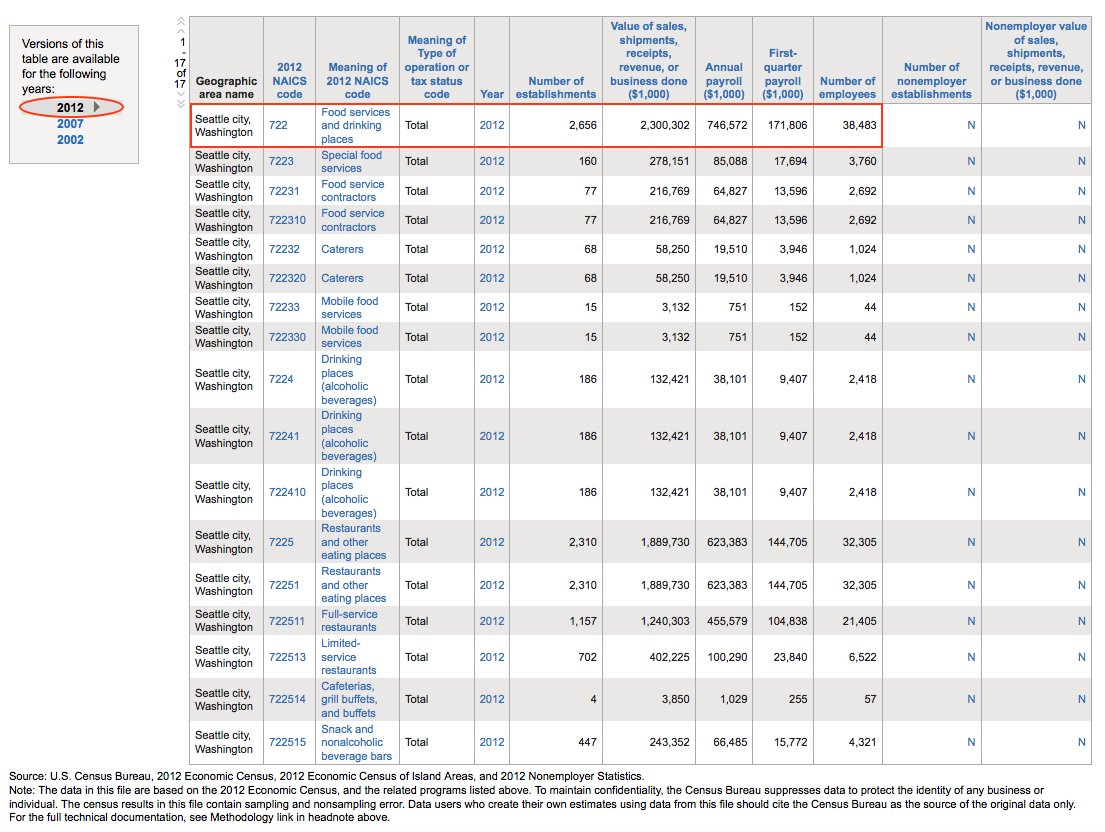
We can also go to the next level up from the city – to King County – and see what that looks like. The state of Washington maintains data that allow us to look at individual counties. Although their data for the time series are not seasonally adjusted, you can use the Census Bureau’s X-13ARIMA-SEATS Seasonal Adjustment software package to adjust the state’s data. So, moving from the city of Seattle to King County, we see the following:
At the end of 2012, there were about 81,300 NAICS 722 workers in the County (versus the 38,000 we know were in the city) and 120,500 in the Sea-Tac-Belle MSA (in 2012). The County currently has about 92,000 NAICS 722 workers versus the aforementioned 135,000 currently in the MSA, so some 43,000 workers are in Pierce and Snohomish Counties. And yes, King County is at a new all-time high in NAICS 722 workers as of August 2015, notwithstanding Professor Perry’s idiocy. It should be fairly easy to see how unhelpful – in fact destructive – Perry’s analysis is.
But wait, there’s more. With the other two counties – Pierce and Snohomish – seasonally adjusted, we can make an apples-to-apples comparison of the three counties that comprise the Sea-Tac-Belle MSA. Starting in June 2014, when the new minimum wage ordinance was passed, here is the breakdown of the MSA’s component counties, indexed to 100 at June 2014:
The problem – as we can clearly see – is in Pierce County, not Seattle’s King County. Professor Perry could have known this, but he’s too lazy to do the work, preferring instead to belch out “think tank” ideology that will get picked up and circulated far and wide. Circling back to a thought I’d had – subsequently echoed by Dr. Vance-Sherman – what did the Sea-Tac-Belle MSA look like versus the rest of the state over time? This is, after all, the crux of Perry’s new argument. Indexing to the end of the Great Recession – June 2009 – the Seattle-Tacoma-Bellevue MSA far outstripped the remainder of the state of Washington for years starting in 2011 and right through present day: 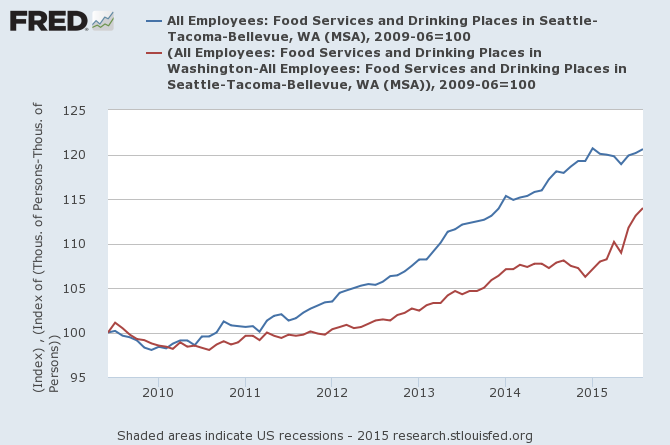 Should we be at all surprised that, perhaps, after four years of lagging, the rest of the state is playing a bit of catch up to the growth in Sea-Tac-Belle? To recap:
Should we be at all surprised that, perhaps, after four years of lagging, the rest of the state is playing a bit of catch up to the growth in Sea-Tac-Belle? To recap:
- Use of the Sea-Tac-Belle MSA data is beyond useless with respect to Seattle’s new minimum wage in the first place. Perry’s continued use of it demonstrates his bad faith.
- That said, within the Sea-Tac-Belle MSA, it is Pierce County that is the drag, not King (in which Seattle resides).
- Washington ex- the Sea-Tac-Belle MSA has lagged in NAICS 722 worker growth for several years running. A bit of catch up should not be surprising.
- Mark Perry’s intellectual dishonesty knows few, if any, bounds.
- It will take literally years to know how the Seattle minimum wage experiment plays out.
- There is no evidence as yet that the April increase is producing any negative effect.
- As I chronicle every Thursday, the number of food service permits in issue for the city has been generally positive.

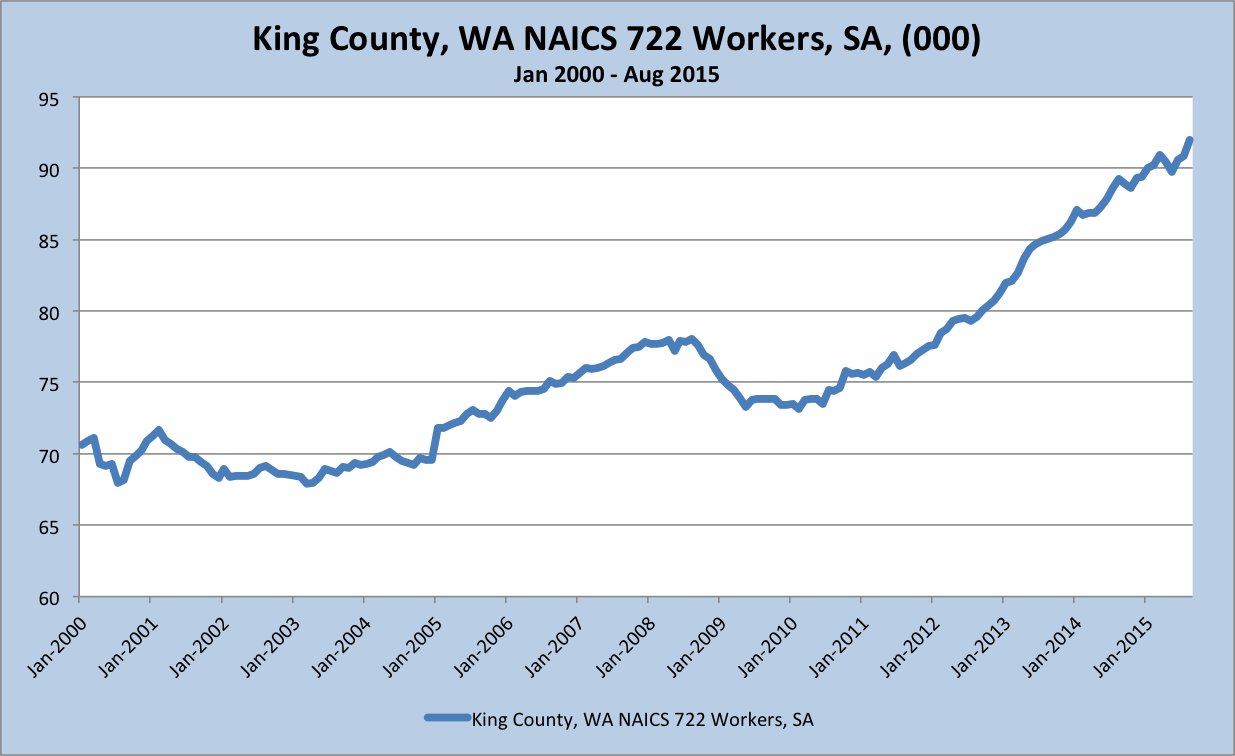
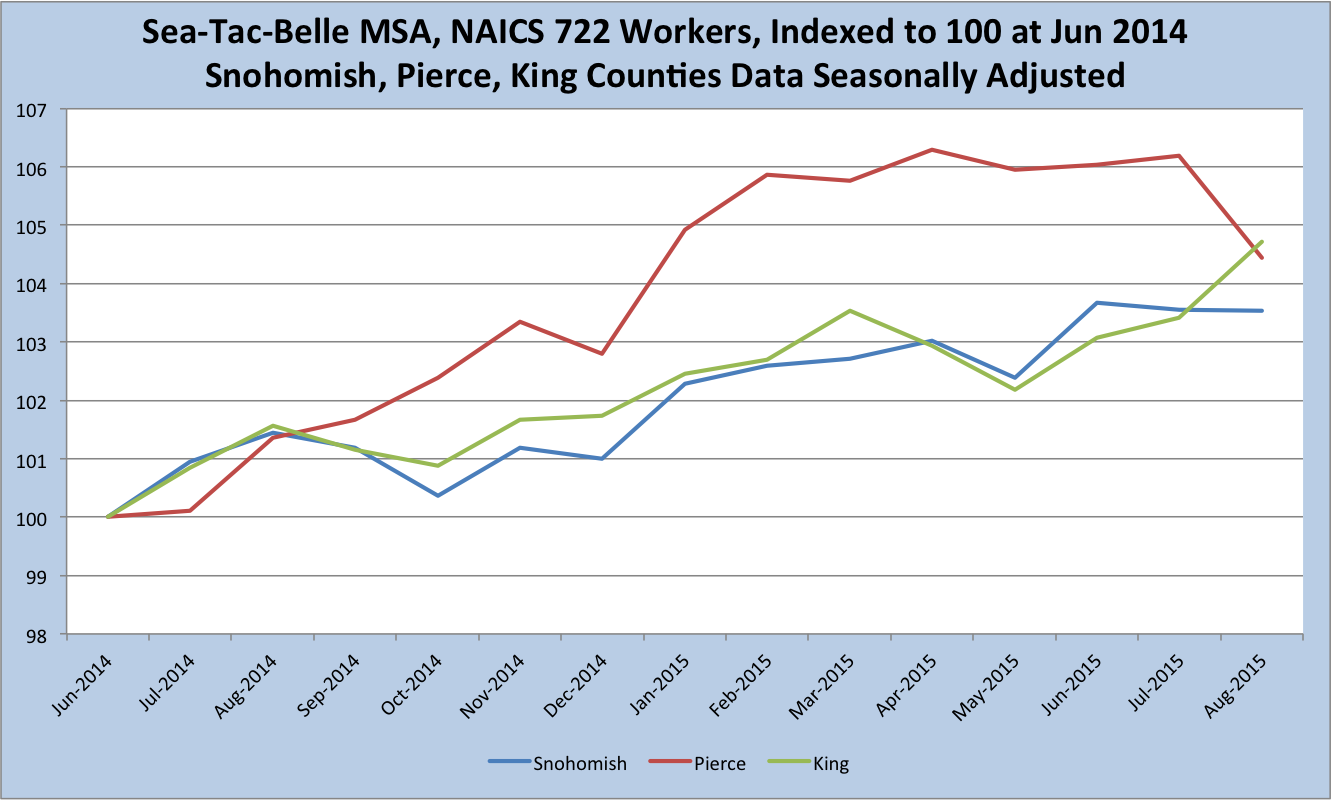

Keep fighting the good fight on this!
Keep… On… Humiliating the Liars.
I would quibble with only one sentence in this post. Perry’s intellectual dishonesty knows one very distinctive bound: the amount which his think tank masters will pay him.
and that – as they say – is the hammer hitting the nail on the head!
Very interesting attempt to tease out the real data, Invictus. About all I can think of to measure the “churn” in the permits is to find out the number of permits terminated due to restuarant closings. Do addresses line up with existing restaurant addresses, or is there fresh growth in the number of locations? After all, it is business deaths that some folks are claiming will increase as a result of the new Wage Law.
Personally, I hope that businesses don’t have to close due to government mandates. I think sometimes wage jumps will hurt an industry and sometimes the wage hike won’t have that effect. So much depends on the commitment to eating out that the local populace has, and the quality of the restaurants at risk. The hangers-on are the mostly the group that will finally succumb to the additional costs.
Why do you always confuse issues with facts?
In the labor market, like in every other market, it is more than acceptable to sell a few less units at twice the price — or something like that. That perspective is perpetually lost in these discussions.
Another wage hike effect anomaly — not applicable here because we are talking about restaurants — is the forever gravitation towards fast food examples when fast food has by far the highest labor costs: 33% compared to Walmart’s 7%. Double Walmart’s $15 an hour ($12.50 claimed wages w,/benefits) to $30 and prices only go up 7%, if that.
I have only one quibble with this outstanding piece. Stop calling him Professor Perry! – it is an insult to real Professors who would never begin with the answer (rather than the question) and never Cherry pick a less relevant dataset/parameter, in order to reach a prespecified conclusion. If you must refer to this hack by title then it is “Professor” Perry.